Civil Engineering Report: Methods and Techniques in Civil Engineering
VerifiedAdded on 2022/08/28
|13
|4106
|50
Report
AI Summary
This report provides a comprehensive overview of civil engineering practices, focusing on earthworks, substructures, site safety, and infrastructure design. It begins by explaining common methods and techniques used in earthworks, including excavation, loading, and hauling, as well as techniques for piling works, foundations, and drainage. The report then delves into site safety, presenting a safety plan, risk assessment, and method statement for various civil engineering activities, including excavations and work in restricted places, while also addressing relevant health and safety legislation. Furthermore, the report evaluates a given civil engineering problem, exploring environmental, geotechnical, quality, and economic frameworks, and proposes a solution. Finally, it prepares a design proposal for a new infrastructure project, specifically highway design, analyzing methods for creating foundations and addressing geotechnical aspects. The report uses the Lok Wo Sha, Shatin, Hong Kong project as a case study, demonstrating the application of these principles in a real-world context.
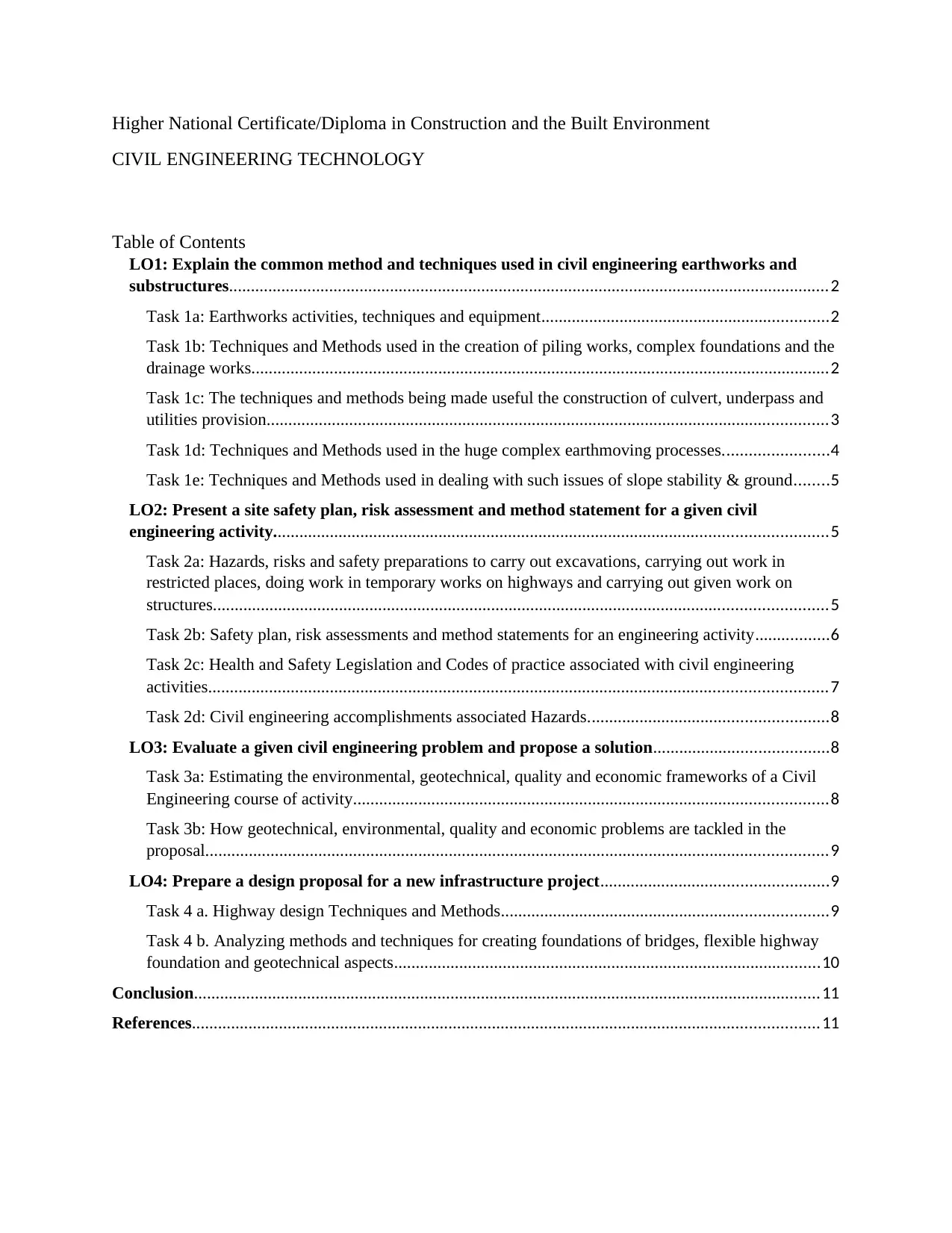
Higher National Certificate/Diploma in Construction and the Built Environment
CIVIL ENGINEERING TECHNOLOGY
Table of Contents
LO1: Explain the common method and techniques used in civil engineering earthworks and
substructures..........................................................................................................................................2
Task 1a: Earthworks activities, techniques and equipment..................................................................2
Task 1b: Techniques and Methods used in the creation of piling works, complex foundations and the
drainage works.....................................................................................................................................2
Task 1c: The techniques and methods being made useful the construction of culvert, underpass and
utilities provision.................................................................................................................................3
Task 1d: Techniques and Methods used in the huge complex earthmoving processes........................4
Task 1e: Techniques and Methods used in dealing with such issues of slope stability & ground........5
LO2: Present a site safety plan, risk assessment and method statement for a given civil
engineering activity...............................................................................................................................5
Task 2a: Hazards, risks and safety preparations to carry out excavations, carrying out work in
restricted places, doing work in temporary works on highways and carrying out given work on
structures.............................................................................................................................................5
Task 2b: Safety plan, risk assessments and method statements for an engineering activity.................6
Task 2c: Health and Safety Legislation and Codes of practice associated with civil engineering
activities..............................................................................................................................................7
Task 2d: Civil engineering accomplishments associated Hazards.......................................................8
LO3: Evaluate a given civil engineering problem and propose a solution........................................8
Task 3a: Estimating the environmental, geotechnical, quality and economic frameworks of a Civil
Engineering course of activity.............................................................................................................8
Task 3b: How geotechnical, environmental, quality and economic problems are tackled in the
proposal...............................................................................................................................................9
LO4: Prepare a design proposal for a new infrastructure project....................................................9
Task 4 a. Highway design Techniques and Methods...........................................................................9
Task 4 b. Analyzing methods and techniques for creating foundations of bridges, flexible highway
foundation and geotechnical aspects..................................................................................................10
Conclusion................................................................................................................................................11
References................................................................................................................................................11
CIVIL ENGINEERING TECHNOLOGY
Table of Contents
LO1: Explain the common method and techniques used in civil engineering earthworks and
substructures..........................................................................................................................................2
Task 1a: Earthworks activities, techniques and equipment..................................................................2
Task 1b: Techniques and Methods used in the creation of piling works, complex foundations and the
drainage works.....................................................................................................................................2
Task 1c: The techniques and methods being made useful the construction of culvert, underpass and
utilities provision.................................................................................................................................3
Task 1d: Techniques and Methods used in the huge complex earthmoving processes........................4
Task 1e: Techniques and Methods used in dealing with such issues of slope stability & ground........5
LO2: Present a site safety plan, risk assessment and method statement for a given civil
engineering activity...............................................................................................................................5
Task 2a: Hazards, risks and safety preparations to carry out excavations, carrying out work in
restricted places, doing work in temporary works on highways and carrying out given work on
structures.............................................................................................................................................5
Task 2b: Safety plan, risk assessments and method statements for an engineering activity.................6
Task 2c: Health and Safety Legislation and Codes of practice associated with civil engineering
activities..............................................................................................................................................7
Task 2d: Civil engineering accomplishments associated Hazards.......................................................8
LO3: Evaluate a given civil engineering problem and propose a solution........................................8
Task 3a: Estimating the environmental, geotechnical, quality and economic frameworks of a Civil
Engineering course of activity.............................................................................................................8
Task 3b: How geotechnical, environmental, quality and economic problems are tackled in the
proposal...............................................................................................................................................9
LO4: Prepare a design proposal for a new infrastructure project....................................................9
Task 4 a. Highway design Techniques and Methods...........................................................................9
Task 4 b. Analyzing methods and techniques for creating foundations of bridges, flexible highway
foundation and geotechnical aspects..................................................................................................10
Conclusion................................................................................................................................................11
References................................................................................................................................................11
Paraphrase This Document
Need a fresh take? Get an instant paraphrase of this document with our AI Paraphraser
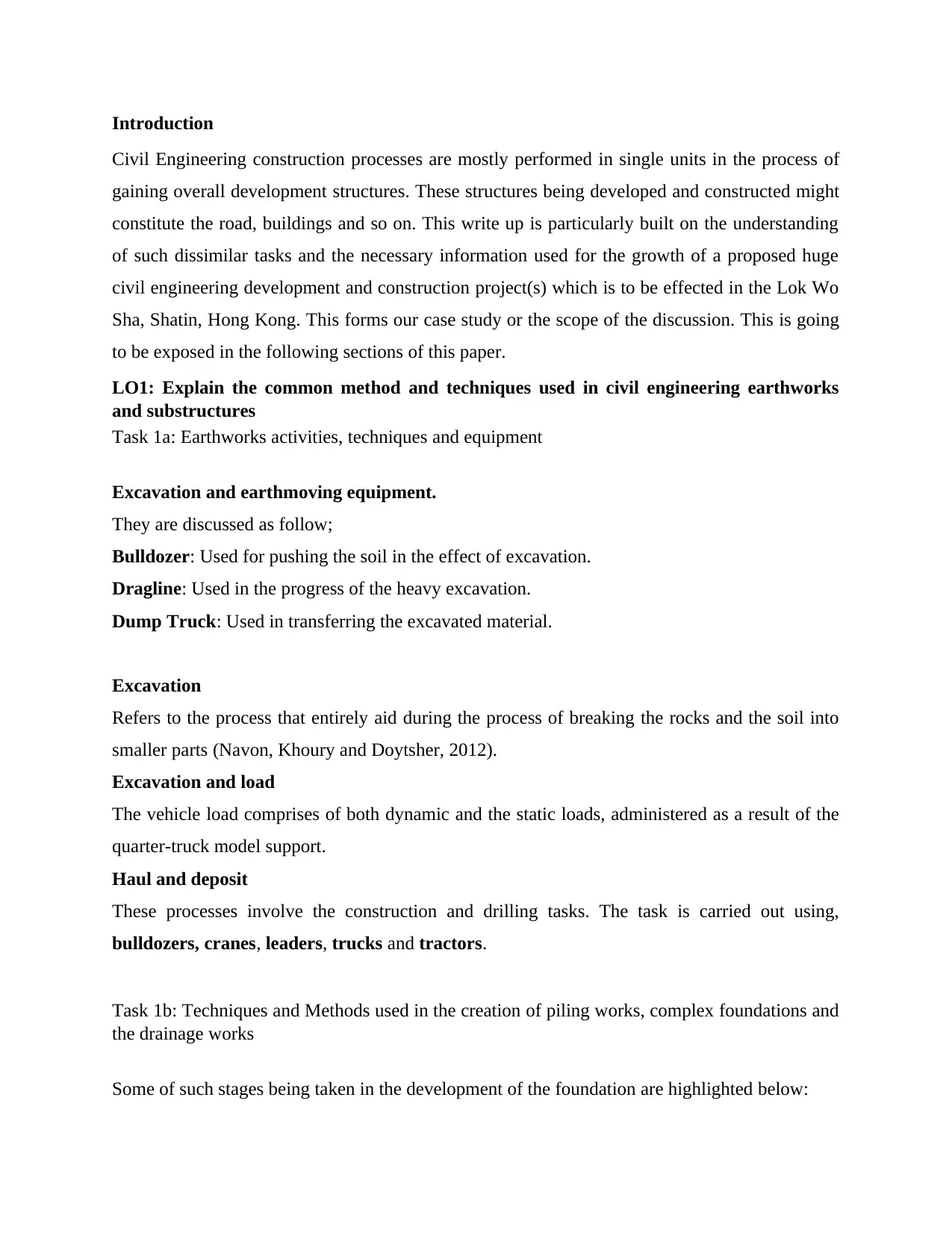
Introduction
Civil Engineering construction processes are mostly performed in single units in the process of
gaining overall development structures. These structures being developed and constructed might
constitute the road, buildings and so on. This write up is particularly built on the understanding
of such dissimilar tasks and the necessary information used for the growth of a proposed huge
civil engineering development and construction project(s) which is to be effected in the Lok Wo
Sha, Shatin, Hong Kong. This forms our case study or the scope of the discussion. This is going
to be exposed in the following sections of this paper.
LO1: Explain the common method and techniques used in civil engineering earthworks
and substructures
Task 1a: Earthworks activities, techniques and equipment
Excavation and earthmoving equipment.
They are discussed as follow;
Bulldozer: Used for pushing the soil in the effect of excavation.
Dragline: Used in the progress of the heavy excavation.
Dump Truck: Used in transferring the excavated material.
Excavation
Refers to the process that entirely aid during the process of breaking the rocks and the soil into
smaller parts (Navon, Khoury and Doytsher, 2012).
Excavation and load
The vehicle load comprises of both dynamic and the static loads, administered as a result of the
quarter-truck model support.
Haul and deposit
These processes involve the construction and drilling tasks. The task is carried out using,
bulldozers, cranes, leaders, trucks and tractors.
Task 1b: Techniques and Methods used in the creation of piling works, complex foundations and
the drainage works
Some of such stages being taken in the development of the foundation are highlighted below:
Civil Engineering construction processes are mostly performed in single units in the process of
gaining overall development structures. These structures being developed and constructed might
constitute the road, buildings and so on. This write up is particularly built on the understanding
of such dissimilar tasks and the necessary information used for the growth of a proposed huge
civil engineering development and construction project(s) which is to be effected in the Lok Wo
Sha, Shatin, Hong Kong. This forms our case study or the scope of the discussion. This is going
to be exposed in the following sections of this paper.
LO1: Explain the common method and techniques used in civil engineering earthworks
and substructures
Task 1a: Earthworks activities, techniques and equipment
Excavation and earthmoving equipment.
They are discussed as follow;
Bulldozer: Used for pushing the soil in the effect of excavation.
Dragline: Used in the progress of the heavy excavation.
Dump Truck: Used in transferring the excavated material.
Excavation
Refers to the process that entirely aid during the process of breaking the rocks and the soil into
smaller parts (Navon, Khoury and Doytsher, 2012).
Excavation and load
The vehicle load comprises of both dynamic and the static loads, administered as a result of the
quarter-truck model support.
Haul and deposit
These processes involve the construction and drilling tasks. The task is carried out using,
bulldozers, cranes, leaders, trucks and tractors.
Task 1b: Techniques and Methods used in the creation of piling works, complex foundations and
the drainage works
Some of such stages being taken in the development of the foundation are highlighted below:
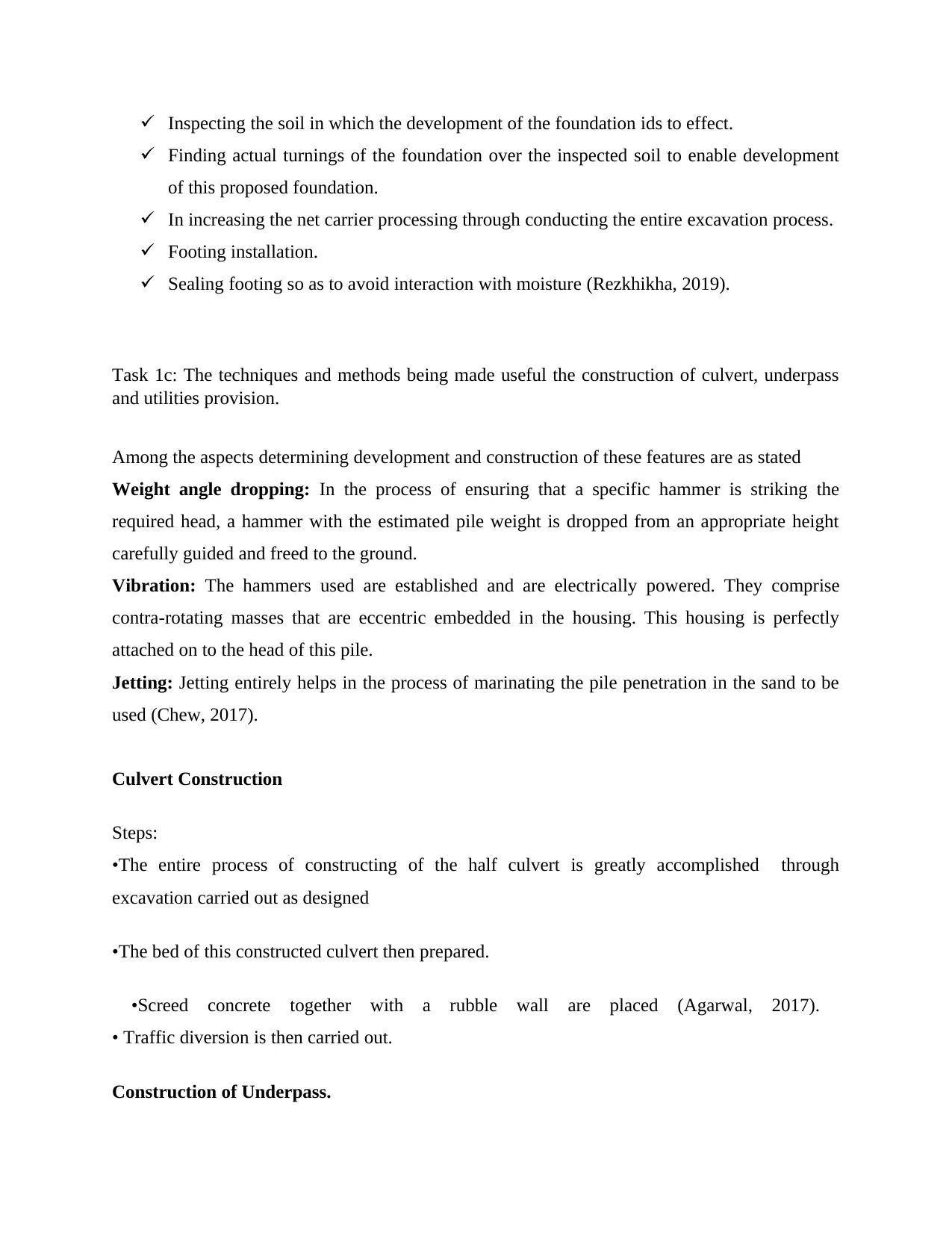
Inspecting the soil in which the development of the foundation ids to effect.
Finding actual turnings of the foundation over the inspected soil to enable development
of this proposed foundation.
In increasing the net carrier processing through conducting the entire excavation process.
Footing installation.
Sealing footing so as to avoid interaction with moisture (Rezkhikha, 2019).
Task 1c: The techniques and methods being made useful the construction of culvert, underpass
and utilities provision.
Among the aspects determining development and construction of these features are as stated
Weight angle dropping: In the process of ensuring that a specific hammer is striking the
required head, a hammer with the estimated pile weight is dropped from an appropriate height
carefully guided and freed to the ground.
Vibration: The hammers used are established and are electrically powered. They comprise
contra-rotating masses that are eccentric embedded in the housing. This housing is perfectly
attached on to the head of this pile.
Jetting: Jetting entirely helps in the process of marinating the pile penetration in the sand to be
used (Chew, 2017).
Culvert Construction
Steps:
•The entire process of constructing of the half culvert is greatly accomplished through
excavation carried out as designed
•The bed of this constructed culvert then prepared.
•Screed concrete together with a rubble wall are placed (Agarwal, 2017).
• Traffic diversion is then carried out.
Construction of Underpass.
Finding actual turnings of the foundation over the inspected soil to enable development
of this proposed foundation.
In increasing the net carrier processing through conducting the entire excavation process.
Footing installation.
Sealing footing so as to avoid interaction with moisture (Rezkhikha, 2019).
Task 1c: The techniques and methods being made useful the construction of culvert, underpass
and utilities provision.
Among the aspects determining development and construction of these features are as stated
Weight angle dropping: In the process of ensuring that a specific hammer is striking the
required head, a hammer with the estimated pile weight is dropped from an appropriate height
carefully guided and freed to the ground.
Vibration: The hammers used are established and are electrically powered. They comprise
contra-rotating masses that are eccentric embedded in the housing. This housing is perfectly
attached on to the head of this pile.
Jetting: Jetting entirely helps in the process of marinating the pile penetration in the sand to be
used (Chew, 2017).
Culvert Construction
Steps:
•The entire process of constructing of the half culvert is greatly accomplished through
excavation carried out as designed
•The bed of this constructed culvert then prepared.
•Screed concrete together with a rubble wall are placed (Agarwal, 2017).
• Traffic diversion is then carried out.
Construction of Underpass.
⊘ This is a preview!⊘
Do you want full access?
Subscribe today to unlock all pages.

Trusted by 1+ million students worldwide
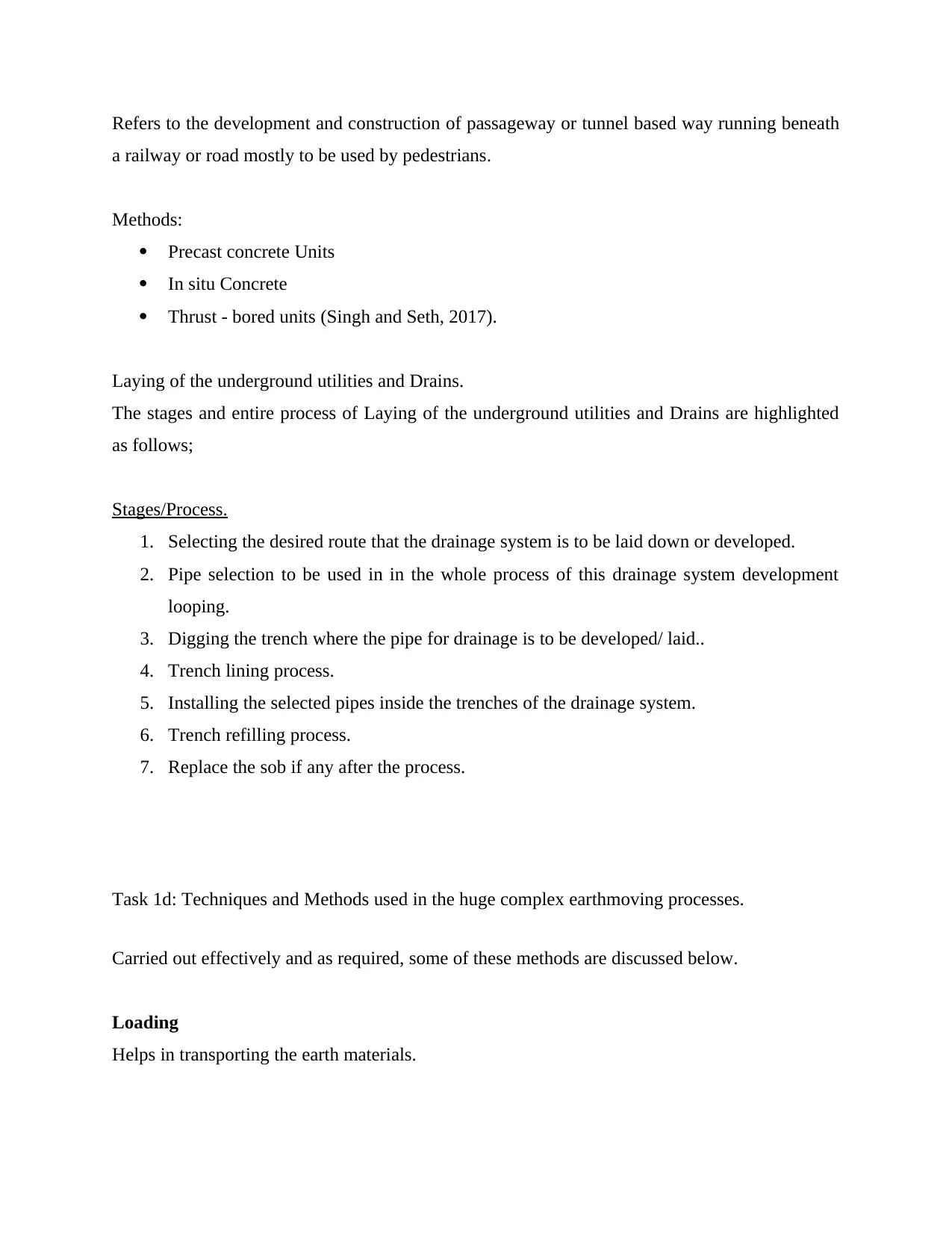
Refers to the development and construction of passageway or tunnel based way running beneath
a railway or road mostly to be used by pedestrians.
Methods:
Precast concrete Units
In situ Concrete
Thrust - bored units (Singh and Seth, 2017).
Laying of the underground utilities and Drains.
The stages and entire process of Laying of the underground utilities and Drains are highlighted
as follows;
Stages/Process.
1. Selecting the desired route that the drainage system is to be laid down or developed.
2. Pipe selection to be used in in the whole process of this drainage system development
looping.
3. Digging the trench where the pipe for drainage is to be developed/ laid..
4. Trench lining process.
5. Installing the selected pipes inside the trenches of the drainage system.
6. Trench refilling process.
7. Replace the sob if any after the process.
Task 1d: Techniques and Methods used in the huge complex earthmoving processes.
Carried out effectively and as required, some of these methods are discussed below.
Loading
Helps in transporting the earth materials.
a railway or road mostly to be used by pedestrians.
Methods:
Precast concrete Units
In situ Concrete
Thrust - bored units (Singh and Seth, 2017).
Laying of the underground utilities and Drains.
The stages and entire process of Laying of the underground utilities and Drains are highlighted
as follows;
Stages/Process.
1. Selecting the desired route that the drainage system is to be laid down or developed.
2. Pipe selection to be used in in the whole process of this drainage system development
looping.
3. Digging the trench where the pipe for drainage is to be developed/ laid..
4. Trench lining process.
5. Installing the selected pipes inside the trenches of the drainage system.
6. Trench refilling process.
7. Replace the sob if any after the process.
Task 1d: Techniques and Methods used in the huge complex earthmoving processes.
Carried out effectively and as required, some of these methods are discussed below.
Loading
Helps in transporting the earth materials.
Paraphrase This Document
Need a fresh take? Get an instant paraphrase of this document with our AI Paraphraser
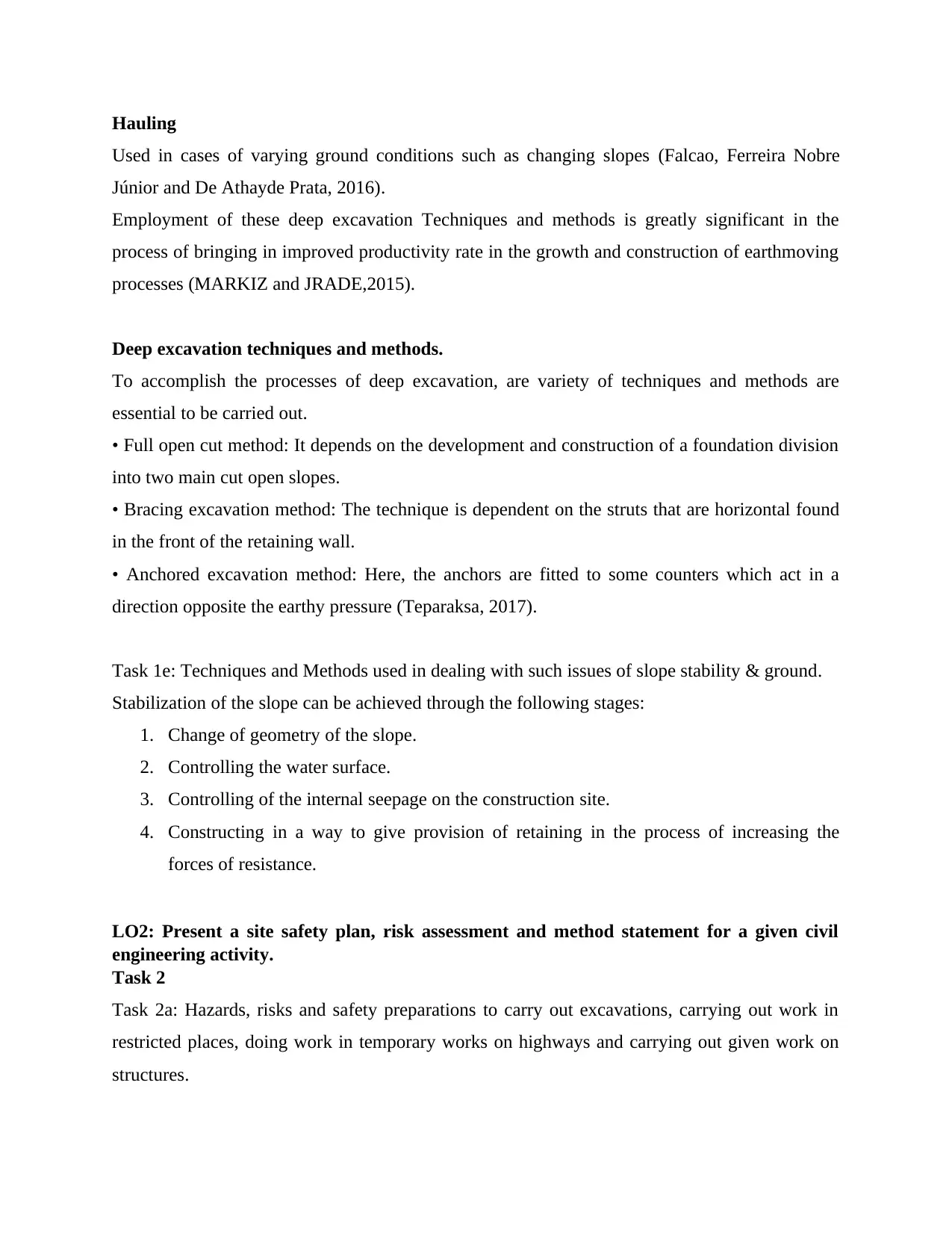
Hauling
Used in cases of varying ground conditions such as changing slopes (Falcao, Ferreira Nobre
Júnior and De Athayde Prata, 2016).
Employment of these deep excavation Techniques and methods is greatly significant in the
process of bringing in improved productivity rate in the growth and construction of earthmoving
processes (MARKIZ and JRADE,2015).
Deep excavation techniques and methods.
To accomplish the processes of deep excavation, are variety of techniques and methods are
essential to be carried out.
• Full open cut method: It depends on the development and construction of a foundation division
into two main cut open slopes.
• Bracing excavation method: The technique is dependent on the struts that are horizontal found
in the front of the retaining wall.
• Anchored excavation method: Here, the anchors are fitted to some counters which act in a
direction opposite the earthy pressure (Teparaksa, 2017).
Task 1e: Techniques and Methods used in dealing with such issues of slope stability & ground.
Stabilization of the slope can be achieved through the following stages:
1. Change of geometry of the slope.
2. Controlling the water surface.
3. Controlling of the internal seepage on the construction site.
4. Constructing in a way to give provision of retaining in the process of increasing the
forces of resistance.
LO2: Present a site safety plan, risk assessment and method statement for a given civil
engineering activity.
Task 2
Task 2a: Hazards, risks and safety preparations to carry out excavations, carrying out work in
restricted places, doing work in temporary works on highways and carrying out given work on
structures.
Used in cases of varying ground conditions such as changing slopes (Falcao, Ferreira Nobre
Júnior and De Athayde Prata, 2016).
Employment of these deep excavation Techniques and methods is greatly significant in the
process of bringing in improved productivity rate in the growth and construction of earthmoving
processes (MARKIZ and JRADE,2015).
Deep excavation techniques and methods.
To accomplish the processes of deep excavation, are variety of techniques and methods are
essential to be carried out.
• Full open cut method: It depends on the development and construction of a foundation division
into two main cut open slopes.
• Bracing excavation method: The technique is dependent on the struts that are horizontal found
in the front of the retaining wall.
• Anchored excavation method: Here, the anchors are fitted to some counters which act in a
direction opposite the earthy pressure (Teparaksa, 2017).
Task 1e: Techniques and Methods used in dealing with such issues of slope stability & ground.
Stabilization of the slope can be achieved through the following stages:
1. Change of geometry of the slope.
2. Controlling the water surface.
3. Controlling of the internal seepage on the construction site.
4. Constructing in a way to give provision of retaining in the process of increasing the
forces of resistance.
LO2: Present a site safety plan, risk assessment and method statement for a given civil
engineering activity.
Task 2
Task 2a: Hazards, risks and safety preparations to carry out excavations, carrying out work in
restricted places, doing work in temporary works on highways and carrying out given work on
structures.
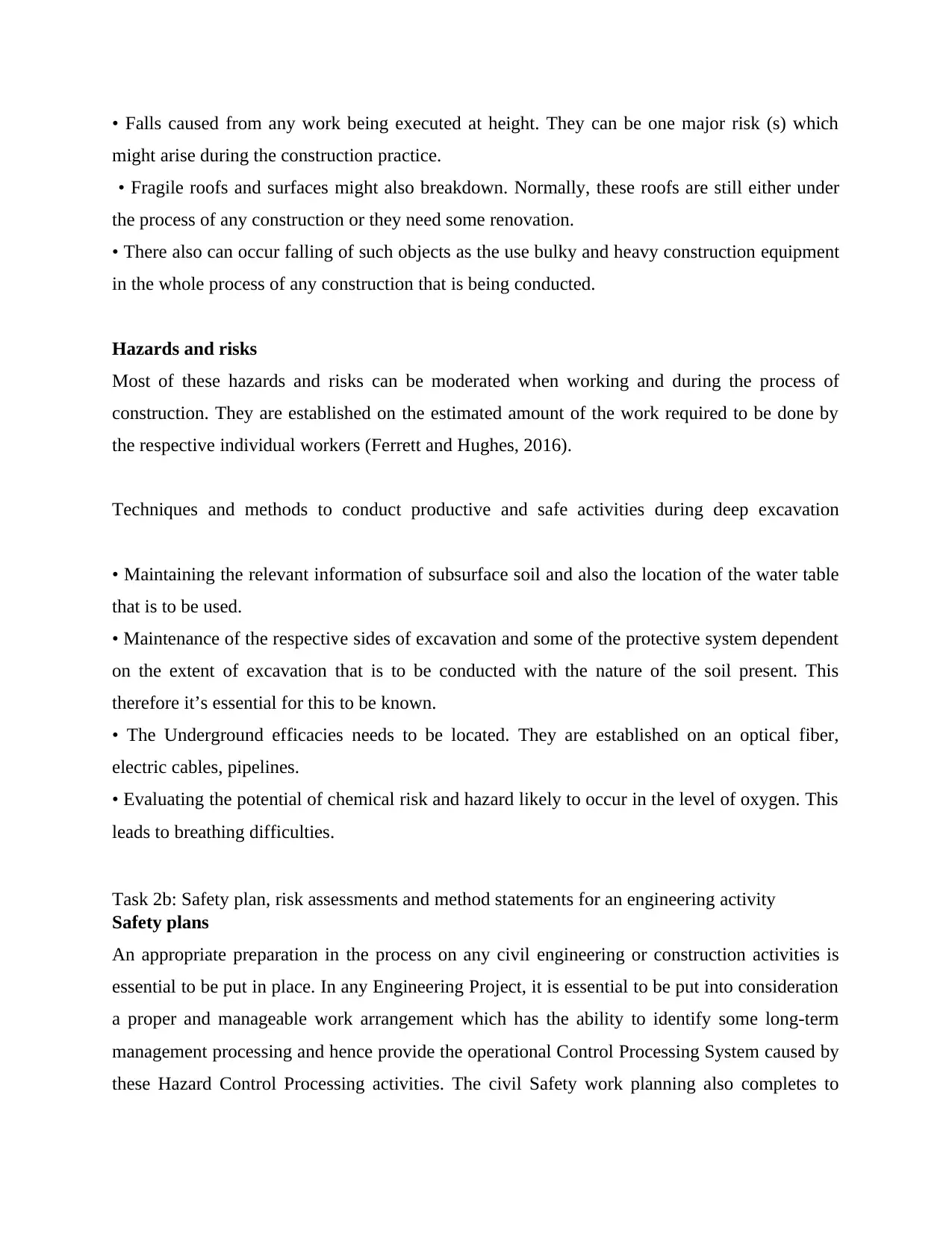
• Falls caused from any work being executed at height. They can be one major risk (s) which
might arise during the construction practice.
• Fragile roofs and surfaces might also breakdown. Normally, these roofs are still either under
the process of any construction or they need some renovation.
• There also can occur falling of such objects as the use bulky and heavy construction equipment
in the whole process of any construction that is being conducted.
Hazards and risks
Most of these hazards and risks can be moderated when working and during the process of
construction. They are established on the estimated amount of the work required to be done by
the respective individual workers (Ferrett and Hughes, 2016).
Techniques and methods to conduct productive and safe activities during deep excavation
• Maintaining the relevant information of subsurface soil and also the location of the water table
that is to be used.
• Maintenance of the respective sides of excavation and some of the protective system dependent
on the extent of excavation that is to be conducted with the nature of the soil present. This
therefore it’s essential for this to be known.
• The Underground efficacies needs to be located. They are established on an optical fiber,
electric cables, pipelines.
• Evaluating the potential of chemical risk and hazard likely to occur in the level of oxygen. This
leads to breathing difficulties.
Task 2b: Safety plan, risk assessments and method statements for an engineering activity
Safety plans
An appropriate preparation in the process on any civil engineering or construction activities is
essential to be put in place. In any Engineering Project, it is essential to be put into consideration
a proper and manageable work arrangement which has the ability to identify some long-term
management processing and hence provide the operational Control Processing System caused by
these Hazard Control Processing activities. The civil Safety work planning also completes to
might arise during the construction practice.
• Fragile roofs and surfaces might also breakdown. Normally, these roofs are still either under
the process of any construction or they need some renovation.
• There also can occur falling of such objects as the use bulky and heavy construction equipment
in the whole process of any construction that is being conducted.
Hazards and risks
Most of these hazards and risks can be moderated when working and during the process of
construction. They are established on the estimated amount of the work required to be done by
the respective individual workers (Ferrett and Hughes, 2016).
Techniques and methods to conduct productive and safe activities during deep excavation
• Maintaining the relevant information of subsurface soil and also the location of the water table
that is to be used.
• Maintenance of the respective sides of excavation and some of the protective system dependent
on the extent of excavation that is to be conducted with the nature of the soil present. This
therefore it’s essential for this to be known.
• The Underground efficacies needs to be located. They are established on an optical fiber,
electric cables, pipelines.
• Evaluating the potential of chemical risk and hazard likely to occur in the level of oxygen. This
leads to breathing difficulties.
Task 2b: Safety plan, risk assessments and method statements for an engineering activity
Safety plans
An appropriate preparation in the process on any civil engineering or construction activities is
essential to be put in place. In any Engineering Project, it is essential to be put into consideration
a proper and manageable work arrangement which has the ability to identify some long-term
management processing and hence provide the operational Control Processing System caused by
these Hazard Control Processing activities. The civil Safety work planning also completes to
⊘ This is a preview!⊘
Do you want full access?
Subscribe today to unlock all pages.

Trusted by 1+ million students worldwide
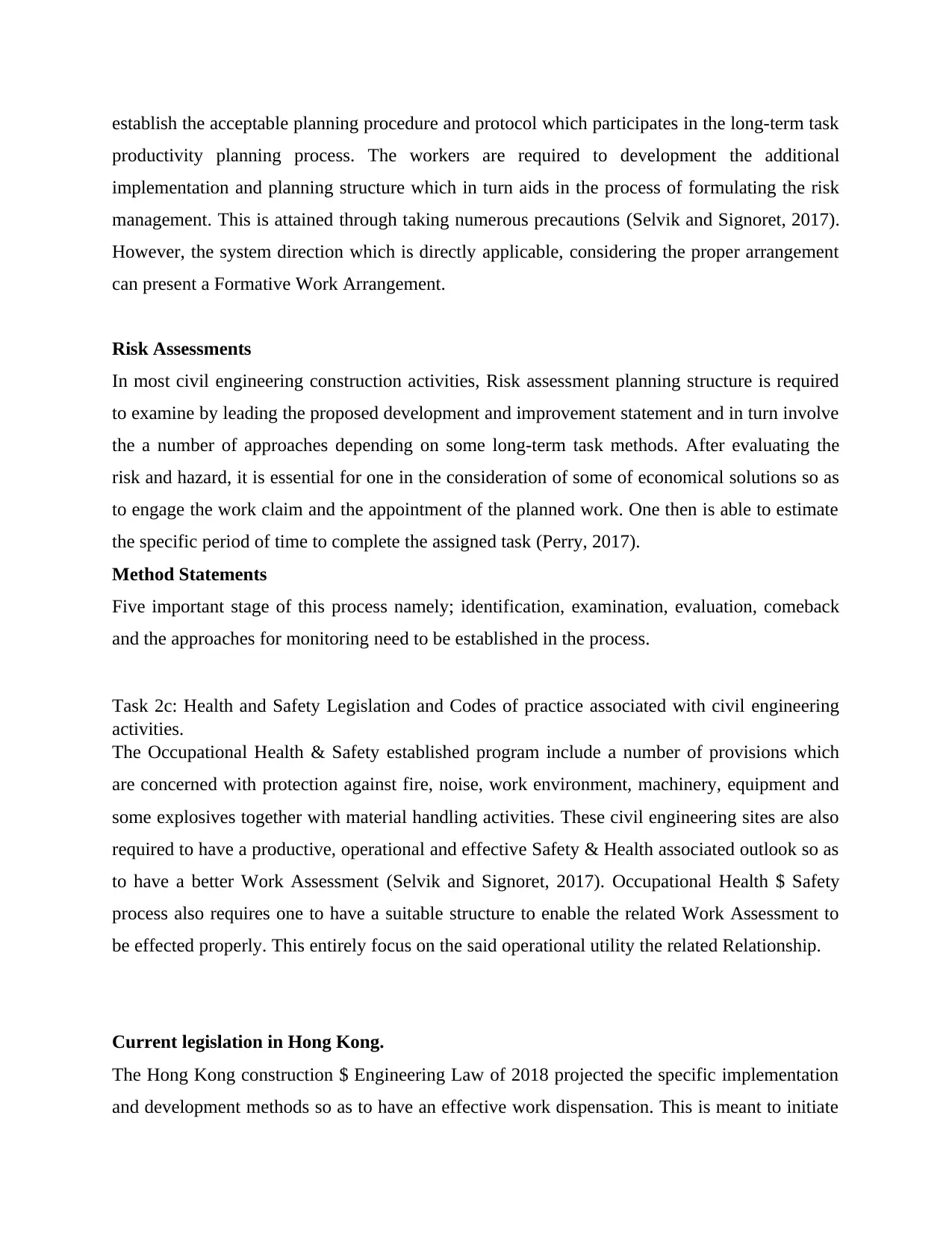
establish the acceptable planning procedure and protocol which participates in the long-term task
productivity planning process. The workers are required to development the additional
implementation and planning structure which in turn aids in the process of formulating the risk
management. This is attained through taking numerous precautions (Selvik and Signoret, 2017).
However, the system direction which is directly applicable, considering the proper arrangement
can present a Formative Work Arrangement.
Risk Assessments
In most civil engineering construction activities, Risk assessment planning structure is required
to examine by leading the proposed development and improvement statement and in turn involve
the a number of approaches depending on some long-term task methods. After evaluating the
risk and hazard, it is essential for one in the consideration of some of economical solutions so as
to engage the work claim and the appointment of the planned work. One then is able to estimate
the specific period of time to complete the assigned task (Perry, 2017).
Method Statements
Five important stage of this process namely; identification, examination, evaluation, comeback
and the approaches for monitoring need to be established in the process.
Task 2c: Health and Safety Legislation and Codes of practice associated with civil engineering
activities.
The Occupational Health & Safety established program include a number of provisions which
are concerned with protection against fire, noise, work environment, machinery, equipment and
some explosives together with material handling activities. These civil engineering sites are also
required to have a productive, operational and effective Safety & Health associated outlook so as
to have a better Work Assessment (Selvik and Signoret, 2017). Occupational Health $ Safety
process also requires one to have a suitable structure to enable the related Work Assessment to
be effected properly. This entirely focus on the said operational utility the related Relationship.
Current legislation in Hong Kong.
The Hong Kong construction $ Engineering Law of 2018 projected the specific implementation
and development methods so as to have an effective work dispensation. This is meant to initiate
productivity planning process. The workers are required to development the additional
implementation and planning structure which in turn aids in the process of formulating the risk
management. This is attained through taking numerous precautions (Selvik and Signoret, 2017).
However, the system direction which is directly applicable, considering the proper arrangement
can present a Formative Work Arrangement.
Risk Assessments
In most civil engineering construction activities, Risk assessment planning structure is required
to examine by leading the proposed development and improvement statement and in turn involve
the a number of approaches depending on some long-term task methods. After evaluating the
risk and hazard, it is essential for one in the consideration of some of economical solutions so as
to engage the work claim and the appointment of the planned work. One then is able to estimate
the specific period of time to complete the assigned task (Perry, 2017).
Method Statements
Five important stage of this process namely; identification, examination, evaluation, comeback
and the approaches for monitoring need to be established in the process.
Task 2c: Health and Safety Legislation and Codes of practice associated with civil engineering
activities.
The Occupational Health & Safety established program include a number of provisions which
are concerned with protection against fire, noise, work environment, machinery, equipment and
some explosives together with material handling activities. These civil engineering sites are also
required to have a productive, operational and effective Safety & Health associated outlook so as
to have a better Work Assessment (Selvik and Signoret, 2017). Occupational Health $ Safety
process also requires one to have a suitable structure to enable the related Work Assessment to
be effected properly. This entirely focus on the said operational utility the related Relationship.
Current legislation in Hong Kong.
The Hong Kong construction $ Engineering Law of 2018 projected the specific implementation
and development methods so as to have an effective work dispensation. This is meant to initiate
Paraphrase This Document
Need a fresh take? Get an instant paraphrase of this document with our AI Paraphraser
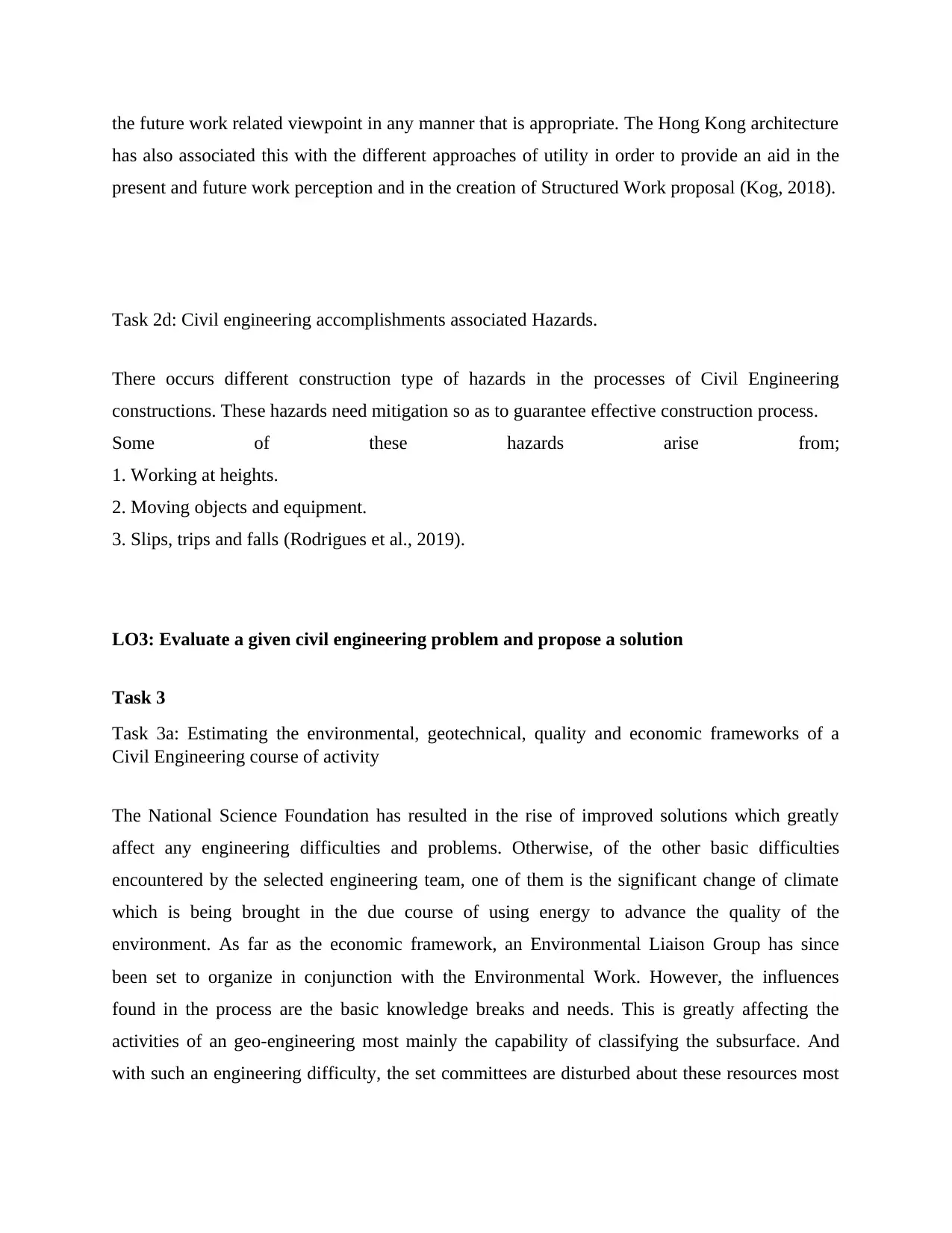
the future work related viewpoint in any manner that is appropriate. The Hong Kong architecture
has also associated this with the different approaches of utility in order to provide an aid in the
present and future work perception and in the creation of Structured Work proposal (Kog, 2018).
Task 2d: Civil engineering accomplishments associated Hazards.
There occurs different construction type of hazards in the processes of Civil Engineering
constructions. These hazards need mitigation so as to guarantee effective construction process.
Some of these hazards arise from;
1. Working at heights.
2. Moving objects and equipment.
3. Slips, trips and falls (Rodrigues et al., 2019).
LO3: Evaluate a given civil engineering problem and propose a solution
Task 3
Task 3a: Estimating the environmental, geotechnical, quality and economic frameworks of a
Civil Engineering course of activity
The National Science Foundation has resulted in the rise of improved solutions which greatly
affect any engineering difficulties and problems. Otherwise, of the other basic difficulties
encountered by the selected engineering team, one of them is the significant change of climate
which is being brought in the due course of using energy to advance the quality of the
environment. As far as the economic framework, an Environmental Liaison Group has since
been set to organize in conjunction with the Environmental Work. However, the influences
found in the process are the basic knowledge breaks and needs. This is greatly affecting the
activities of an geo-engineering most mainly the capability of classifying the subsurface. And
with such an engineering difficulty, the set committees are disturbed about these resources most
has also associated this with the different approaches of utility in order to provide an aid in the
present and future work perception and in the creation of Structured Work proposal (Kog, 2018).
Task 2d: Civil engineering accomplishments associated Hazards.
There occurs different construction type of hazards in the processes of Civil Engineering
constructions. These hazards need mitigation so as to guarantee effective construction process.
Some of these hazards arise from;
1. Working at heights.
2. Moving objects and equipment.
3. Slips, trips and falls (Rodrigues et al., 2019).
LO3: Evaluate a given civil engineering problem and propose a solution
Task 3
Task 3a: Estimating the environmental, geotechnical, quality and economic frameworks of a
Civil Engineering course of activity
The National Science Foundation has resulted in the rise of improved solutions which greatly
affect any engineering difficulties and problems. Otherwise, of the other basic difficulties
encountered by the selected engineering team, one of them is the significant change of climate
which is being brought in the due course of using energy to advance the quality of the
environment. As far as the economic framework, an Environmental Liaison Group has since
been set to organize in conjunction with the Environmental Work. However, the influences
found in the process are the basic knowledge breaks and needs. This is greatly affecting the
activities of an geo-engineering most mainly the capability of classifying the subsurface. And
with such an engineering difficulty, the set committees are disturbed about these resources most
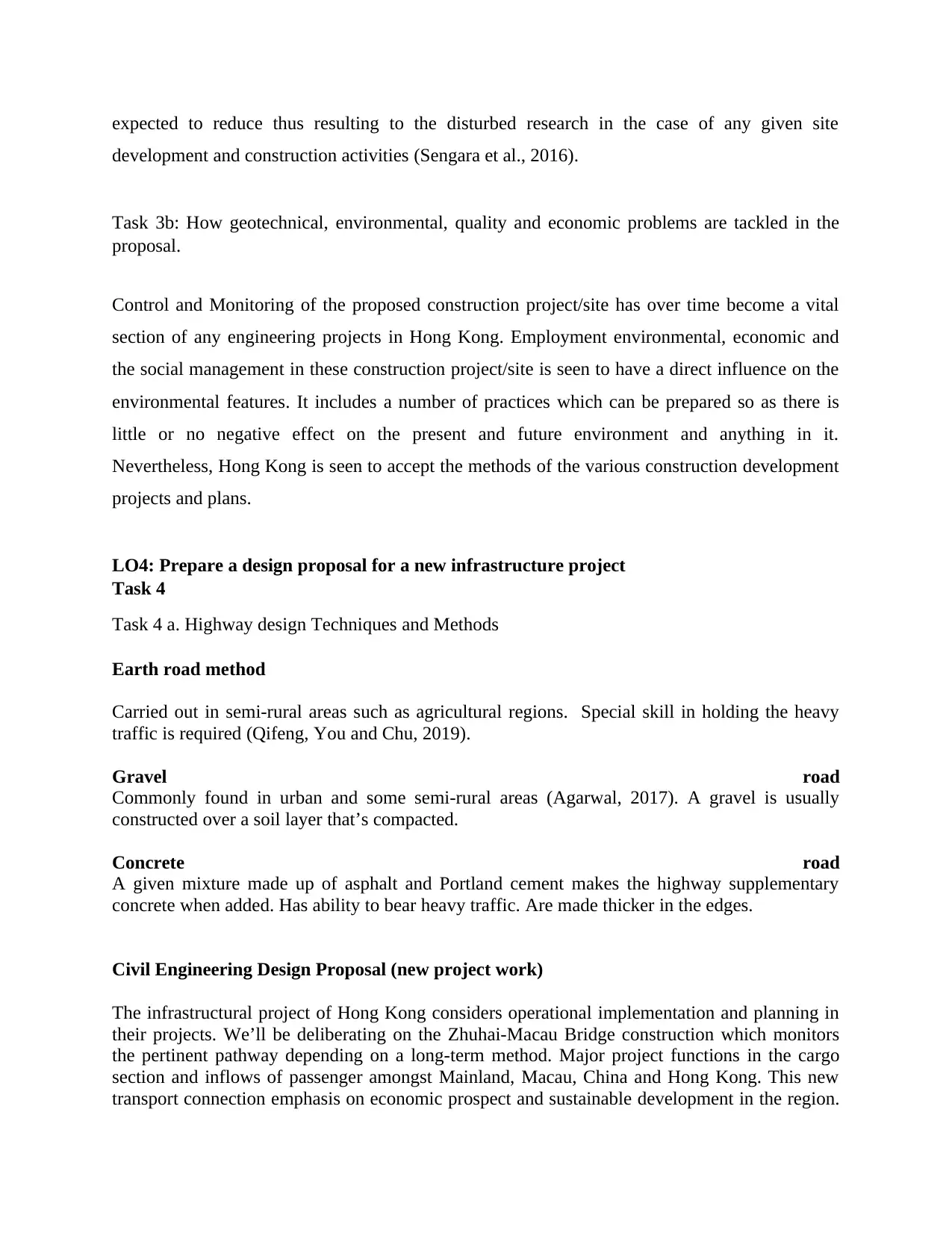
expected to reduce thus resulting to the disturbed research in the case of any given site
development and construction activities (Sengara et al., 2016).
Task 3b: How geotechnical, environmental, quality and economic problems are tackled in the
proposal.
Control and Monitoring of the proposed construction project/site has over time become a vital
section of any engineering projects in Hong Kong. Employment environmental, economic and
the social management in these construction project/site is seen to have a direct influence on the
environmental features. It includes a number of practices which can be prepared so as there is
little or no negative effect on the present and future environment and anything in it.
Nevertheless, Hong Kong is seen to accept the methods of the various construction development
projects and plans.
LO4: Prepare a design proposal for a new infrastructure project
Task 4
Task 4 a. Highway design Techniques and Methods
Earth road method
Carried out in semi-rural areas such as agricultural regions. Special skill in holding the heavy
traffic is required (Qifeng, You and Chu, 2019).
Gravel road
Commonly found in urban and some semi-rural areas (Agarwal, 2017). A gravel is usually
constructed over a soil layer that’s compacted.
Concrete road
A given mixture made up of asphalt and Portland cement makes the highway supplementary
concrete when added. Has ability to bear heavy traffic. Are made thicker in the edges.
Civil Engineering Design Proposal (new project work)
The infrastructural project of Hong Kong considers operational implementation and planning in
their projects. We’ll be deliberating on the Zhuhai-Macau Bridge construction which monitors
the pertinent pathway depending on a long-term method. Major project functions in the cargo
section and inflows of passenger amongst Mainland, Macau, China and Hong Kong. This new
transport connection emphasis on economic prospect and sustainable development in the region.
development and construction activities (Sengara et al., 2016).
Task 3b: How geotechnical, environmental, quality and economic problems are tackled in the
proposal.
Control and Monitoring of the proposed construction project/site has over time become a vital
section of any engineering projects in Hong Kong. Employment environmental, economic and
the social management in these construction project/site is seen to have a direct influence on the
environmental features. It includes a number of practices which can be prepared so as there is
little or no negative effect on the present and future environment and anything in it.
Nevertheless, Hong Kong is seen to accept the methods of the various construction development
projects and plans.
LO4: Prepare a design proposal for a new infrastructure project
Task 4
Task 4 a. Highway design Techniques and Methods
Earth road method
Carried out in semi-rural areas such as agricultural regions. Special skill in holding the heavy
traffic is required (Qifeng, You and Chu, 2019).
Gravel road
Commonly found in urban and some semi-rural areas (Agarwal, 2017). A gravel is usually
constructed over a soil layer that’s compacted.
Concrete road
A given mixture made up of asphalt and Portland cement makes the highway supplementary
concrete when added. Has ability to bear heavy traffic. Are made thicker in the edges.
Civil Engineering Design Proposal (new project work)
The infrastructural project of Hong Kong considers operational implementation and planning in
their projects. We’ll be deliberating on the Zhuhai-Macau Bridge construction which monitors
the pertinent pathway depending on a long-term method. Major project functions in the cargo
section and inflows of passenger amongst Mainland, Macau, China and Hong Kong. This new
transport connection emphasis on economic prospect and sustainable development in the region.
⊘ This is a preview!⊘
Do you want full access?
Subscribe today to unlock all pages.

Trusted by 1+ million students worldwide
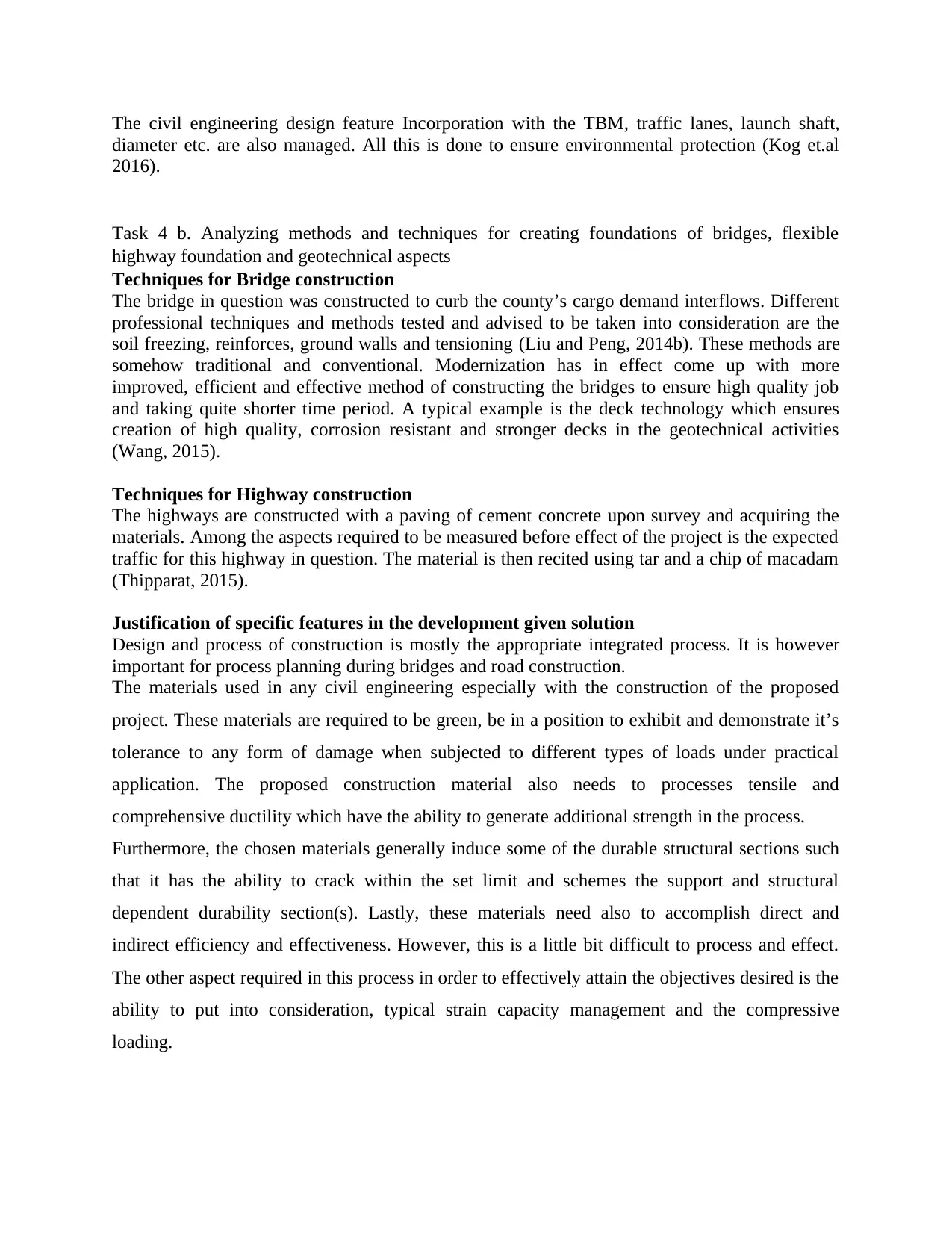
The civil engineering design feature Incorporation with the TBM, traffic lanes, launch shaft,
diameter etc. are also managed. All this is done to ensure environmental protection (Kog et.al
2016).
Task 4 b. Analyzing methods and techniques for creating foundations of bridges, flexible
highway foundation and geotechnical aspects
Techniques for Bridge construction
The bridge in question was constructed to curb the county’s cargo demand interflows. Different
professional techniques and methods tested and advised to be taken into consideration are the
soil freezing, reinforces, ground walls and tensioning (Liu and Peng, 2014b). These methods are
somehow traditional and conventional. Modernization has in effect come up with more
improved, efficient and effective method of constructing the bridges to ensure high quality job
and taking quite shorter time period. A typical example is the deck technology which ensures
creation of high quality, corrosion resistant and stronger decks in the geotechnical activities
(Wang, 2015).
Techniques for Highway construction
The highways are constructed with a paving of cement concrete upon survey and acquiring the
materials. Among the aspects required to be measured before effect of the project is the expected
traffic for this highway in question. The material is then recited using tar and a chip of macadam
(Thipparat, 2015).
Justification of specific features in the development given solution
Design and process of construction is mostly the appropriate integrated process. It is however
important for process planning during bridges and road construction.
The materials used in any civil engineering especially with the construction of the proposed
project. These materials are required to be green, be in a position to exhibit and demonstrate it’s
tolerance to any form of damage when subjected to different types of loads under practical
application. The proposed construction material also needs to processes tensile and
comprehensive ductility which have the ability to generate additional strength in the process.
Furthermore, the chosen materials generally induce some of the durable structural sections such
that it has the ability to crack within the set limit and schemes the support and structural
dependent durability section(s). Lastly, these materials need also to accomplish direct and
indirect efficiency and effectiveness. However, this is a little bit difficult to process and effect.
The other aspect required in this process in order to effectively attain the objectives desired is the
ability to put into consideration, typical strain capacity management and the compressive
loading.
diameter etc. are also managed. All this is done to ensure environmental protection (Kog et.al
2016).
Task 4 b. Analyzing methods and techniques for creating foundations of bridges, flexible
highway foundation and geotechnical aspects
Techniques for Bridge construction
The bridge in question was constructed to curb the county’s cargo demand interflows. Different
professional techniques and methods tested and advised to be taken into consideration are the
soil freezing, reinforces, ground walls and tensioning (Liu and Peng, 2014b). These methods are
somehow traditional and conventional. Modernization has in effect come up with more
improved, efficient and effective method of constructing the bridges to ensure high quality job
and taking quite shorter time period. A typical example is the deck technology which ensures
creation of high quality, corrosion resistant and stronger decks in the geotechnical activities
(Wang, 2015).
Techniques for Highway construction
The highways are constructed with a paving of cement concrete upon survey and acquiring the
materials. Among the aspects required to be measured before effect of the project is the expected
traffic for this highway in question. The material is then recited using tar and a chip of macadam
(Thipparat, 2015).
Justification of specific features in the development given solution
Design and process of construction is mostly the appropriate integrated process. It is however
important for process planning during bridges and road construction.
The materials used in any civil engineering especially with the construction of the proposed
project. These materials are required to be green, be in a position to exhibit and demonstrate it’s
tolerance to any form of damage when subjected to different types of loads under practical
application. The proposed construction material also needs to processes tensile and
comprehensive ductility which have the ability to generate additional strength in the process.
Furthermore, the chosen materials generally induce some of the durable structural sections such
that it has the ability to crack within the set limit and schemes the support and structural
dependent durability section(s). Lastly, these materials need also to accomplish direct and
indirect efficiency and effectiveness. However, this is a little bit difficult to process and effect.
The other aspect required in this process in order to effectively attain the objectives desired is the
ability to put into consideration, typical strain capacity management and the compressive
loading.
Paraphrase This Document
Need a fresh take? Get an instant paraphrase of this document with our AI Paraphraser
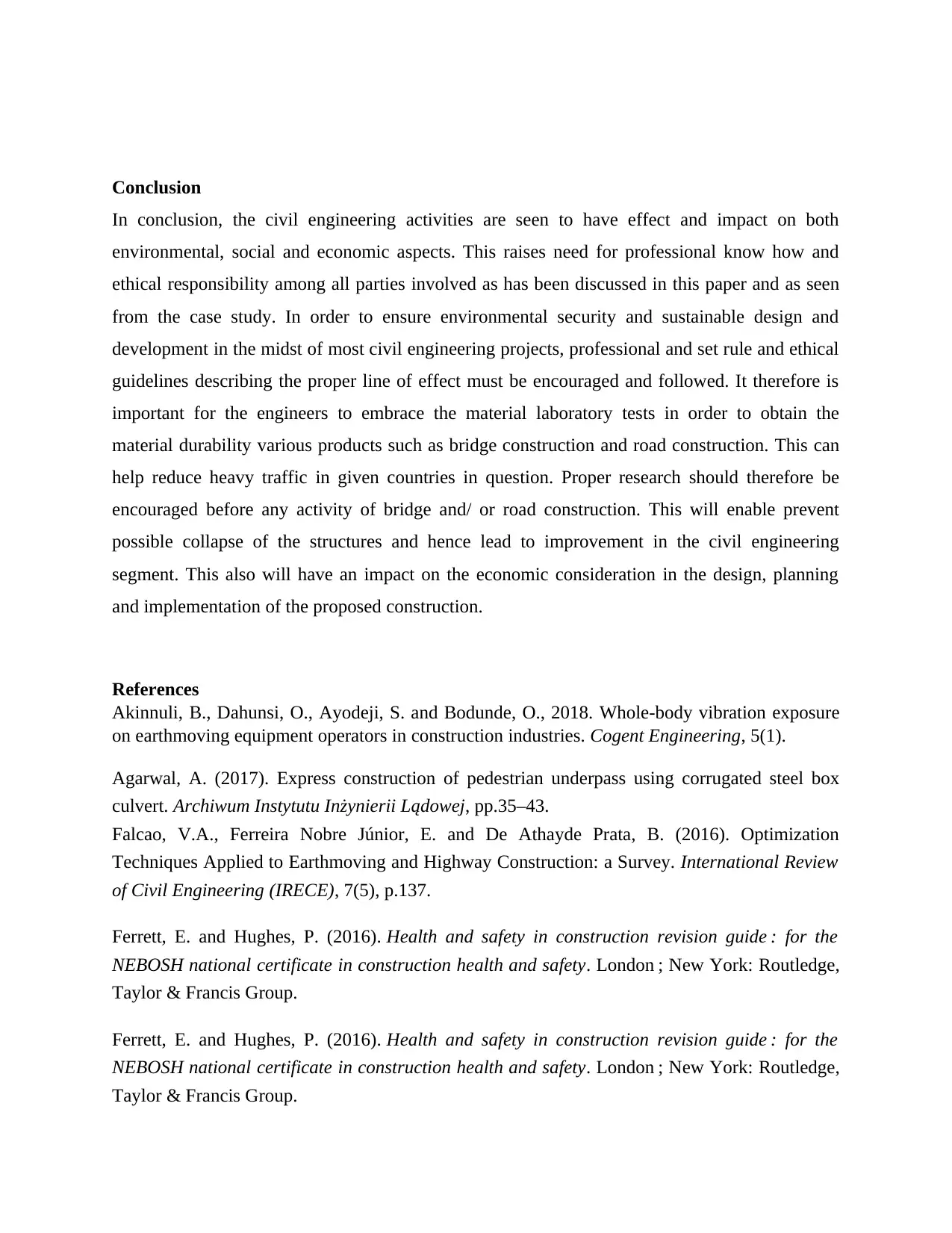
Conclusion
In conclusion, the civil engineering activities are seen to have effect and impact on both
environmental, social and economic aspects. This raises need for professional know how and
ethical responsibility among all parties involved as has been discussed in this paper and as seen
from the case study. In order to ensure environmental security and sustainable design and
development in the midst of most civil engineering projects, professional and set rule and ethical
guidelines describing the proper line of effect must be encouraged and followed. It therefore is
important for the engineers to embrace the material laboratory tests in order to obtain the
material durability various products such as bridge construction and road construction. This can
help reduce heavy traffic in given countries in question. Proper research should therefore be
encouraged before any activity of bridge and/ or road construction. This will enable prevent
possible collapse of the structures and hence lead to improvement in the civil engineering
segment. This also will have an impact on the economic consideration in the design, planning
and implementation of the proposed construction.
References
Akinnuli, B., Dahunsi, O., Ayodeji, S. and Bodunde, O., 2018. Whole-body vibration exposure
on earthmoving equipment operators in construction industries. Cogent Engineering, 5(1).
Agarwal, A. (2017). Express construction of pedestrian underpass using corrugated steel box
culvert. Archiwum Instytutu Inżynierii Lądowej, pp.35–43.
Falcao, V.A., Ferreira Nobre Júnior, E. and De Athayde Prata, B. (2016). Optimization
Techniques Applied to Earthmoving and Highway Construction: a Survey. International Review
of Civil Engineering (IRECE), 7(5), p.137.
Ferrett, E. and Hughes, P. (2016). Health and safety in construction revision guide : for the
NEBOSH national certificate in construction health and safety. London ; New York: Routledge,
Taylor & Francis Group.
Ferrett, E. and Hughes, P. (2016). Health and safety in construction revision guide : for the
NEBOSH national certificate in construction health and safety. London ; New York: Routledge,
Taylor & Francis Group.
In conclusion, the civil engineering activities are seen to have effect and impact on both
environmental, social and economic aspects. This raises need for professional know how and
ethical responsibility among all parties involved as has been discussed in this paper and as seen
from the case study. In order to ensure environmental security and sustainable design and
development in the midst of most civil engineering projects, professional and set rule and ethical
guidelines describing the proper line of effect must be encouraged and followed. It therefore is
important for the engineers to embrace the material laboratory tests in order to obtain the
material durability various products such as bridge construction and road construction. This can
help reduce heavy traffic in given countries in question. Proper research should therefore be
encouraged before any activity of bridge and/ or road construction. This will enable prevent
possible collapse of the structures and hence lead to improvement in the civil engineering
segment. This also will have an impact on the economic consideration in the design, planning
and implementation of the proposed construction.
References
Akinnuli, B., Dahunsi, O., Ayodeji, S. and Bodunde, O., 2018. Whole-body vibration exposure
on earthmoving equipment operators in construction industries. Cogent Engineering, 5(1).
Agarwal, A. (2017). Express construction of pedestrian underpass using corrugated steel box
culvert. Archiwum Instytutu Inżynierii Lądowej, pp.35–43.
Falcao, V.A., Ferreira Nobre Júnior, E. and De Athayde Prata, B. (2016). Optimization
Techniques Applied to Earthmoving and Highway Construction: a Survey. International Review
of Civil Engineering (IRECE), 7(5), p.137.
Ferrett, E. and Hughes, P. (2016). Health and safety in construction revision guide : for the
NEBOSH national certificate in construction health and safety. London ; New York: Routledge,
Taylor & Francis Group.
Ferrett, E. and Hughes, P. (2016). Health and safety in construction revision guide : for the
NEBOSH national certificate in construction health and safety. London ; New York: Routledge,
Taylor & Francis Group.
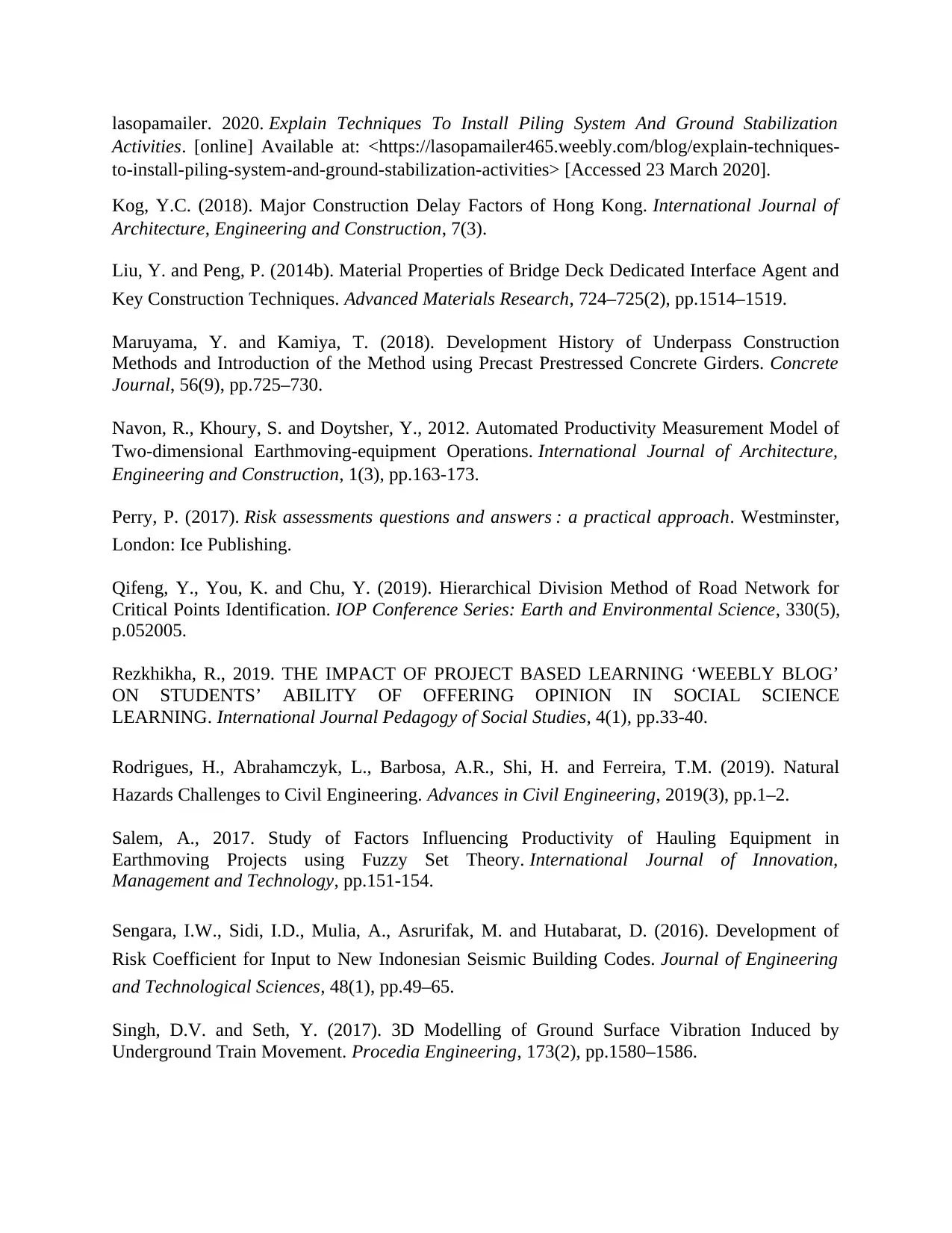
lasopamailer. 2020. Explain Techniques To Install Piling System And Ground Stabilization
Activities. [online] Available at: <https://lasopamailer465.weebly.com/blog/explain-techniques-
to-install-piling-system-and-ground-stabilization-activities> [Accessed 23 March 2020].
Kog, Y.C. (2018). Major Construction Delay Factors of Hong Kong. International Journal of
Architecture, Engineering and Construction, 7(3).
Liu, Y. and Peng, P. (2014b). Material Properties of Bridge Deck Dedicated Interface Agent and
Key Construction Techniques. Advanced Materials Research, 724–725(2), pp.1514–1519.
Maruyama, Y. and Kamiya, T. (2018). Development History of Underpass Construction
Methods and Introduction of the Method using Precast Prestressed Concrete Girders. Concrete
Journal, 56(9), pp.725–730.
Navon, R., Khoury, S. and Doytsher, Y., 2012. Automated Productivity Measurement Model of
Two-dimensional Earthmoving-equipment Operations. International Journal of Architecture,
Engineering and Construction, 1(3), pp.163-173.
Perry, P. (2017). Risk assessments questions and answers : a practical approach. Westminster,
London: Ice Publishing.
Qifeng, Y., You, K. and Chu, Y. (2019). Hierarchical Division Method of Road Network for
Critical Points Identification. IOP Conference Series: Earth and Environmental Science, 330(5),
p.052005.
Rezkhikha, R., 2019. THE IMPACT OF PROJECT BASED LEARNING ‘WEEBLY BLOG’
ON STUDENTS’ ABILITY OF OFFERING OPINION IN SOCIAL SCIENCE
LEARNING. International Journal Pedagogy of Social Studies, 4(1), pp.33-40.
Rodrigues, H., Abrahamczyk, L., Barbosa, A.R., Shi, H. and Ferreira, T.M. (2019). Natural
Hazards Challenges to Civil Engineering. Advances in Civil Engineering, 2019(3), pp.1–2.
Salem, A., 2017. Study of Factors Influencing Productivity of Hauling Equipment in
Earthmoving Projects using Fuzzy Set Theory. International Journal of Innovation,
Management and Technology, pp.151-154.
Sengara, I.W., Sidi, I.D., Mulia, A., Asrurifak, M. and Hutabarat, D. (2016). Development of
Risk Coefficient for Input to New Indonesian Seismic Building Codes. Journal of Engineering
and Technological Sciences, 48(1), pp.49–65.
Singh, D.V. and Seth, Y. (2017). 3D Modelling of Ground Surface Vibration Induced by
Underground Train Movement. Procedia Engineering, 173(2), pp.1580–1586.
Activities. [online] Available at: <https://lasopamailer465.weebly.com/blog/explain-techniques-
to-install-piling-system-and-ground-stabilization-activities> [Accessed 23 March 2020].
Kog, Y.C. (2018). Major Construction Delay Factors of Hong Kong. International Journal of
Architecture, Engineering and Construction, 7(3).
Liu, Y. and Peng, P. (2014b). Material Properties of Bridge Deck Dedicated Interface Agent and
Key Construction Techniques. Advanced Materials Research, 724–725(2), pp.1514–1519.
Maruyama, Y. and Kamiya, T. (2018). Development History of Underpass Construction
Methods and Introduction of the Method using Precast Prestressed Concrete Girders. Concrete
Journal, 56(9), pp.725–730.
Navon, R., Khoury, S. and Doytsher, Y., 2012. Automated Productivity Measurement Model of
Two-dimensional Earthmoving-equipment Operations. International Journal of Architecture,
Engineering and Construction, 1(3), pp.163-173.
Perry, P. (2017). Risk assessments questions and answers : a practical approach. Westminster,
London: Ice Publishing.
Qifeng, Y., You, K. and Chu, Y. (2019). Hierarchical Division Method of Road Network for
Critical Points Identification. IOP Conference Series: Earth and Environmental Science, 330(5),
p.052005.
Rezkhikha, R., 2019. THE IMPACT OF PROJECT BASED LEARNING ‘WEEBLY BLOG’
ON STUDENTS’ ABILITY OF OFFERING OPINION IN SOCIAL SCIENCE
LEARNING. International Journal Pedagogy of Social Studies, 4(1), pp.33-40.
Rodrigues, H., Abrahamczyk, L., Barbosa, A.R., Shi, H. and Ferreira, T.M. (2019). Natural
Hazards Challenges to Civil Engineering. Advances in Civil Engineering, 2019(3), pp.1–2.
Salem, A., 2017. Study of Factors Influencing Productivity of Hauling Equipment in
Earthmoving Projects using Fuzzy Set Theory. International Journal of Innovation,
Management and Technology, pp.151-154.
Sengara, I.W., Sidi, I.D., Mulia, A., Asrurifak, M. and Hutabarat, D. (2016). Development of
Risk Coefficient for Input to New Indonesian Seismic Building Codes. Journal of Engineering
and Technological Sciences, 48(1), pp.49–65.
Singh, D.V. and Seth, Y. (2017). 3D Modelling of Ground Surface Vibration Induced by
Underground Train Movement. Procedia Engineering, 173(2), pp.1580–1586.
⊘ This is a preview!⊘
Do you want full access?
Subscribe today to unlock all pages.

Trusted by 1+ million students worldwide
1 out of 13
Related Documents
Your All-in-One AI-Powered Toolkit for Academic Success.
+13062052269
info@desklib.com
Available 24*7 on WhatsApp / Email
![[object Object]](/_next/static/media/star-bottom.7253800d.svg)
Unlock your academic potential
Copyright © 2020–2025 A2Z Services. All Rights Reserved. Developed and managed by ZUCOL.


